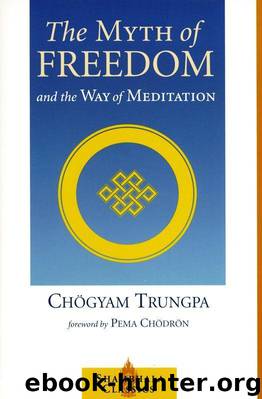The Myth of Freedom and the Way of Meditation (Shambhala Classics) by Trungpa Chogyam

Author:Trungpa, Chogyam [Trungpa, Chogyam]
Language: eng
Format: azw3
Publisher: Shambhala Publications
Published: 2010-09-28T03:00:00+00:00
The Eightfold Path
THERE SEEM TO be so many sidetracks in relating to our life situations, sidetracks of all kinds by which we are seduced: “Food, gas, and lodging, next exit.” We are always promised something if we turn right at the next exit as we travel down our highway. There are so many colorful advertisements. We never want to be just where and what we are; we always want to be somewhere else. We can always turn right at the next exit, even though we really know we are stuck on our highway anyway, that we really have no choice about it. Where we are is embarrassing, and so we would like to hear somebody say that there is an alternative whereby we do not have to be ashamed of ourselves: “I’ll provide a mask, just put it on.” Then you can get off at that exit and you are “saved” by pretending to be what you are not. You think people see you as a different person, the one wearing the mask of what you would like to be.
Buddhism promises nothing. It teaches us to be what we are where we are, constantly, and it teaches us to relate to our living situations accordingly. That seems to be the way to proceed on our highway without being distracted by the sidetracks and exits of all kinds. The signs say: “Tibetan Village, next exit”; “Japanese Village, next exit”; “Nirvana, next exit”; “Enlightenment, next exit—instant one”; “Disneyland, next exit.” If you turn right, everything is going to be okay. You get what you are promised. But after having gone to Disneyland or having taken part in the Nirvana Festival, then you have to think about how you are going to get back to your car, how you are going to get home. This means you have to get back on the highway once more. It is unavoidable. I am afraid that this portrays our basic situation, the process in which we are constantly involved.
I am sorry not to be presenting any glamorous and beautiful promises. Wisdom happens to be a domestic affair. Buddha saw the world as it is and that was his enlightenment. Buddha means “awake,” being awake, completely awake—that seems to be his message to us. He offered us a path to being awake, a path with eight points, and he called it “the eightfold path.”
The first point the Buddha made has to do with “right view.” Wrong view is a matter of conceptualization. Someone is walking toward us—suddenly we freeze. Not only do we freeze ourselves, but we also freeze the space in which the person is walking toward us. We call him “friend” who is walking through this space or “enemy.” Thus the person is automatically walking through a frozen situation of fixed ideas—“this is that” or “this is not that.” This is what Buddha called “wrong view.” It is a conceptualized view which is imperfect because we do not see the situation as it is. There is the possibility, on the other hand, of not freezing that space.
Download
This site does not store any files on its server. We only index and link to content provided by other sites. Please contact the content providers to delete copyright contents if any and email us, we'll remove relevant links or contents immediately.
The Way of Zen by Alan W. Watts(6503)
Ego Is the Enemy by Ryan Holiday(5292)
The Art of Happiness by The Dalai Lama(4063)
The Book of Joy by Dalai Lama(3897)
Why Buddhism is True by Robert Wright(3401)
Spark Joy by Marie Kondo(3246)
Shift into Freedom by Loch Kelly(3134)
Happiness by Matthieu Ricard(2989)
A Monk's Guide to a Clean House and Mind by Shoukei Matsumoto(2866)
The Lost Art of Good Conversation by Sakyong Mipham(2574)
The Meaning of the Library by unknow(2503)
The Unfettered Mind: Writings from a Zen Master to a Master Swordsman by Takuan Soho(2249)
The Third Eye by T. Lobsang Rampa(2224)
Anthology by T J(2158)
Red Shambhala by Andrei Znamenski(2147)
The Diamond Cutter by Geshe Michael Roach(2016)
Thoughts Without A Thinker: Psychotherapy from a Buddhist Perspective by Epstein Mark(1961)
Twilight of Idols and Anti-Christ by Friedrich Nietzsche(1848)
Advice Not Given by Mark Epstein(1838)
